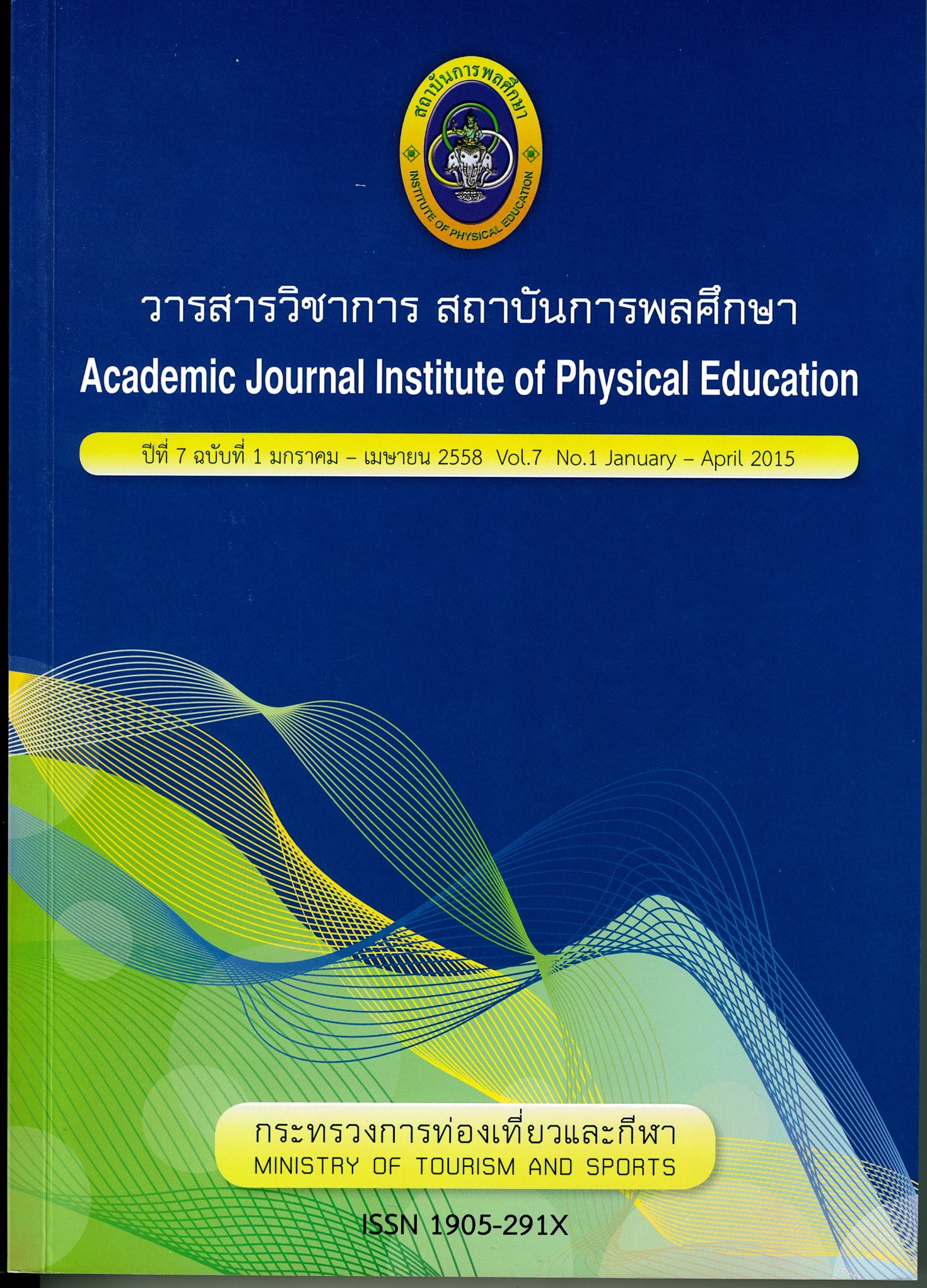Participatory Learning Process in Environmental Management to Reduce Smoke Pollution from Burning in Baan-kuan Community, Harnkwaew Sub-district, Hang Dong District, Chiang Mai Province
Main Article Content
Abstract
The primary purpose of this study was aimed to examine the participatory learning process in environmental management to reduce smoke pollution emitted from burning that affects health, Ban Kaun Community, Hankaew, Hang Dong, Chiang Mai. The sample included those concerned people, consisting of community leaders, entrepreneurs in the community,and community representatives in the village, health volunteers, and staffs from Hankaew health promoting hospital, Chiang Mai. In this study, the Participatory Learning: PL was applied to analyze the problem, priority of the problem, find out the solutions, and reduce smoke pollution that has affected to people's health. For data collection, the researcher collected qualitative data through the use of spreadsheet of the group process, a summary on Mind Mapping, and audio recorder. Data was presented in composition format.
- The causes of smoke pollution that aggravate the amount of the smog included as follows; people mainly use firewood to cook a meal, burning wood chips, leaves, trash, plastic scraps, burning straw to prepare agricultural plots, incineration of plastic instead of the use of black garbage bags for disposal, using motorcycles and cars as vehicles that cause the smoke, the way of life in the community which most are likely to be a potter; burning clay pots is needed steadily, in addition; the community also have
ork factories and meatballs factories which is another source of smog pollution, smoke of various grilled and toxic fumes, smoke from the engine and motorcycles.
- Smoke pollution's effect from burning that affect to people's health, family and Ban Kaun community; 1) effect on health; respiratory effects such as difficulty breathing, sore throat, allergies, asthma, lung cancer, acute disease, heart disease, and cardiovascular disease, and adverse effect on pregnant women, 2) effect on mental health, causing irritation, 3) effect on economy and tourism, causing the reduced number of tourists and economic stagnation, and 4 ) effect on community life, causing air pollution and global warming.
- Regarding to self care and community health care of the smoke pollution from burning, it found that 1) Personal health care : avoid to stay near high level of smoke pollution area, use a mask or a sanitary mask to prevent toxic fumes, daily exercise for good health, eating entire 5 nutrient groups regularly, take care of the family members health, if occurred symptoms such as burning eyes , respiratory system disorder or illness, see a doctor. 2 ) community health care : including community campaign to reduce burning, broadcasting a ban on the incineration in the community, raise awareness in the community to stop the burning.
- The environmental management in Ban Kuan community for prevent and reduce smoke pollution that affect health, it found that : The participant needs to invite the lectural to lecture for the problems, knowledge and effects to health from the smoke pollution, the participation of the people to reduce burning, separate the garbage for recycle, use of bicycles instead of motorcycles and reforestation
- Results of participatory learning process in environmental management : the participants request for 1) The compost from agricultural waste project, 2) The recycled waste purchase Project, 3) Kiln pottery preparation project and 4) Incinerators reducing smoke pollution project. The projects under the current implementation include compost from agricultural waste, and recycled waste purchase project. For Kiln Pottery preparation project and the incinerators reducing smoke pollution project, the agencies involved include Hankaew Municipality, enterprises and public agencies in the area who jointly take responsibility. However, both projects are still in the duration of examination for model and suitability of the area.
Article Details

This work is licensed under a Creative Commons Attribution-NonCommercial-NoDerivatives 4.0 International License.
The published article is a copyright of the Academic Journal of Thailand National Sports University. The passage appeared in each article in this academic journal is a perspective of each author which is not related to the journal. Each author is required to be responsible for all components of his/her own article. If there are any mistakes, each author must be responsible for those mistakes on his/her own.
References
กรมควบคุมมลพิษ กระทรวงทรัพยากรธรรมชาติสิ่งแวดล้อม. (2548), รายงานสถานการณ์มลพิษของประเทศไทยปี 2546. กรุงเทพฯ : กรมควบคุมมลพิษ.
กรมควบคุมมลพิษ กระทรวงทรัพยากรธรรมชาติสิ่งแวดล้อม. (2548). รายงานสถานการณ์มลพิษของประเทศไทยปี 2547. กรุงเทพฯ : กรมควบคุมมลพิษ.
คณะกรรมการศึกษาผลกระทบต่อสุขภาพจากมลพิษสิ่งแวดล้อมในเขตควบคุมมลพิษ จังหวัดระยอง. (2544). รายงานผลการศึกษาผลกระทบต่อสุขภาพจากปัญหามลพิษสิ่งแวดล้อมในเขตควบคุมมลพิษ จังหวัดระยอง, ออนไลน์, สืบค้นเมื่อวันที่ 19 กรกฎาคม 2555.
จริยา วิไลวรรณ. (2550). คู่มือ “คุณFa” วิทยากรกระบวนการผู้สร้างการเรียนรู้แบบมีส่วนร่วม (Facilitator), กรุงเทพฯ : บริษัทพิมพ์ดี.
ฉัตรนภา อุ่นคํา. (2554). การจัดการผลกระทบของการผลิตอิฐมอญที่มีผลต่อสุขภาพของประชาชนในหมู่บ้านช่างทอง ตําบลสุเทพ อําเภอเมือง จังหวัดเชียงใหม่, วิทยานิพนธ์ศึกษาศาสตรมหาบัณฑิต มหาวิทยาลัยเชียงใหม่,
นรินทร์ชัย พัฒนาพงศา. (2534), การมีส่วนร่วมของประชาชนในการพัฒนาลุ่มน้ํา, วารสารมกราคม - มีนาคม.
นรินทร์ชัย พัฒนพงศา. (2546). การมีส่วนร่วม หลักการพื้นฐาน เทคนิคและกรณีตัวอย่าง. กรุงเทพฯ : 598 พริ้นท์,
เนาวรัตน์ พลายน้อย. (2550). “การเรียนรู้” คู่มือ “คุณFa” วิทยากรกระบวนการผู้สร้างการเรียนรู้แบบส่วนร่วม (Facilitator), จริยา วิไลวรรณ, บรรณาธิการ กรุงเทพฯ:บริษัทพิมพ์ดี.
นันทวัน แก้วไชยหาญ. (2544). การรับรู้ความเสี่ยงต่อสุขภาพในภาวะหมอกควัน ของอาสาสมัครสาธารณสุขประจําหมู่บ้าน ในเขตเทศบาลนครเชียงใหม่, วิทยานิพนธ์ศิลปศาสตรมหาบัณฑิต มหาวิทยาลัยเชียงใหม่.
บุญเชิด ภัญโญอนันตพงษ์. (2540), “การเรียนรู้แบบสรรค์สร้างความรู้” ทฤษฎีการเรียนรู้แบบมีส่วนร่วม:ต้นแบบการเรียนรู้ทางด้านหลักทฤษฎีและแนวปฏิบัติ. หน้า 48-49. กรุงเทพฯ : สํานักงานคณะกรรมการการศึกษาแห่งชาติ.
ปกรณ์ วุวรรณประภา. (2546). วิทยากรกระบวนการภาคสนาม. กรุงเทพฯ : โครงการวิจัยและพัฒนาชีวิตสาธารณะ – ท้องถิ่นน่าอยู่ สถาบันชุมชน – ท้องถิ่นพัฒนา.
ประพันธุ์ศิริ สุเสารัจ. (2540), “กระบวนการกลุ่ม” ใน ทฤษฎีการเรียนรู้แบบมีส่วนร่วม : ต้นแบบการเรียนรู้ทางด้านหลักทฤษฎีและแนวปฏิบัติ. สํานักงานคณะกรรมการการศึกษาแห่งชาติ พระราชบัญญัติส่งเสริมและรักษาสิ่งแวดล้อมแห่งชาติ พ.ศ. 2535 “ความหมายและมิติทางด้านสิ่งแวดล้อม” [ระบบออนไลน์]. แหล่งที่มา www.pcf.go.th สืบค้นเมื่อวันที่ 4 มกราคม พ.ศ. 2555.
พงศ์เทพ วิวรรธนะเดช. (2550). สรุปบทเรียนการจัดการปัญหาหมอกควันในภาคเหนือ, เชียงใหม่ : ศูนย์ประสานข้อมูลปัญหาหมอกควัน ในพื้นที่ภาคเหนือ ภาควิชาเวชศาสตร์ชุมชน คณะแพทยศาสตร์ มหาวิทยาลัยเชียงใหม่,
พงศ์เทพ วิวรรธนะเดช. (2548). รายงานวิจัยระดับรายวันของฝุ่นในอากาศและผลกระทบต่อสุขภาพ ของผู้ป่วยที่เป็นหอบหืดจังหวัดเชียงใหม่และลําพูน, เชียงใหม่ : ภาควิชาเวชศาสตร์ป้องกัน. มหาวิทยาลัยชียงใหม่.
ยุพาพร รูปงาม. (2545). รูปแบบการบริหารแบบมีส่วนร่วมในองค์กรที่มีประสิทธิผลระดับคณะของสถาบันอุดมศึกษา, กรุงเทพฯ : จุฬาลงกรณ์มหาวิทยาลัย.
รัฐธรรมนูญแห่งชาติอาณาจักรไทย. (2550). หมวด 5 นโยบายด้านการมีส่วนร่วมของประชาชน. (ระบบออนไลน์]. แหล่งที่มา : www.wikisorce. Org สืบค้นเมื่อวันที่ 4 มกราคม พ.ศ. 2555.
วิทวัส แกล้วทะนง. (2541). “การมีส่วนร่วมของประชาชนในการจัดการทรัพยากรน้ําในพื้นที่ลุ่มน้ําปากพนัง จังหวัดนครศรีธรรมราช” : สารนิพนธ์วิทยาศาสตร์มหาบัณฑิต สาขาการจัดการสิ่งแวดล้อม สํานักพัฒนบัณฑิตศึกษา สถาบันบัณฑิตพัฒนบริหารศาสตร์,
สุเทพ อ่วมเจริญ. (2549). การเรียนรู้แบบมีส่วนร่วม. [ระบบออนไลน์]. แหล่งที่มา : http://cddweb.cdd.go.th/tr_di/documentary/tr_dihrddoc004.html สืบค้นเมื่อวันที่ 28 มกราคม 2550
สุภณิดา ปุสุรินทร์คํา. (2551). หลักการเรียนรู้แบบมีส่วนร่วม. (ระบบออนไลน์]. แหล่งที่มา : www.opalnida.blospot.com สืบค้นเมื่อวันที่ 19 มีนาคม พ.ศ. 2556.
สุมณฑา พรหมบุญ. (2540), “การเรียนรู้แบบมีส่วนร่วม” ใน ทฤษฎีการเรียนรู้แบบมีส่วนร่วม : ต้นแบบการเรียนรู้ทางด้านหลักทฤษฎีและแนวปฏิบัติ สํานักงานคณะกรรมการการศึกษาแห่งชาติ,
สมใจ ปราบพล. (2544), การจัดกระบวนการเรียนรู้ที่เน้นผู้เรียนเป็นสําคัญ “การสอนแบบทักษะชีวิตแบบมีส่วนร่วม.” กรุงเทพฯ : สํานักงานคณะกรรมการการศึกษาแห่งชาติ สํานักนายกรัฐมนตรี.
สํานักงานสิ่งแวดล้อมภาคที่ 1 จังหวัดเชียงใหม่. (2548). รายงานความก้าวหน้าการแก้ไขปัญหามลพิษทางอากาศจังหวัดเชียงใหม่, สํานักงานปลัดกระทรวงทรัพยากรธรรมชาติและสิ่งแวดล้อม.
สํานักงานสิ่งแวดล้อมภาคที่ 10. (2544). รายงานสถานการณ์คุณภาพสิ่งแวดล้อมภาคเหนือตอนบน (จังหวัดเชียงราย เชียงใหม่ แม่ฮ่องสอน พะเยา ลําปาง และลําพูน) ประจําปี 2555. กรุงเทพฯ : สํานักงานนโยบายและแผนสิ่งแวดล้อม กระทรวงวิทยาศาสตร์เทคโนโลยีและสิ่งแวดล้อม.
อดิน รพีพัฒน์. (2547). การมีส่วนร่วมของชุมชนในการพัฒนาชุมชนในสภาพสังคมและวัฒนธรรมไทยศูนย์ศึกษานโยบายสาธารณสุข. มหาวิทยาลัยมหิดล.
อดิน เวียงแสง และคณะ. (2548). การติดตามและประเมินผลแบบมีส่วนร่วม. กรุงเทพฯ : โครงการเสริมสร้างการเรียนรู้เพื่อชุมชน.
อภิญญา กังสนารักษ์. (2544), รูปแบบการบริหารแบบมีส่วนร่วมในองค์กรที่มีประสิทธิผลระดับคณะของสถาบันอุดมศึกษา. กรุงเทพฯ : จุฬาลงกรณ์มหาวิทยาลัย.
อรจรีย์ ณ ตะกั่วทุ่ง. (2545). สุดยอดพัฒนาการเรียนการสอน กรุงเทพมหานคร : เอ็กซเปอร์เน็ทบุคส์,
อรพรรณ พรสีมา. (2540), “การเรียนรู้แบบร่วมแรงร่วมใจ” ใน ทฤษฎีการเรียนรู้แบบมีส่วนร่วม : ต้นแบบการเรียนรู้ทางด้านหลักทฤษฎีและแนวปฏิบัติ. สํานักงานคณะกรรมการการศึกษา แห่งชาติ


